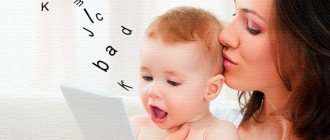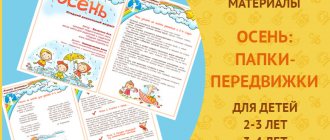Syllables for reading: cards and table
Content
Before learning to read, a child must learn the very concept of syllables. Before learning to read and write, your child must recognize letters and be able to relate them to sounds. The next stage is learning syllables. Interesting manuals for studying syllables can be downloaded from our website.
Is it difficult to teach a child to combine letters into syllables?
How to learn to read?
At the beginning of learning to read, it is necessary to convey to the child such concepts as vowel and consonant sounds and letters. Vowel sounds can be stressed or unstressed. Among the consonants, there are voiced and voiceless, hard and soft.
By the way, special attention should be paid to the hardness and softness of sounds. This characteristic of sounds within a syllable is determined by soft or hard signs or vowels located after consonants.
So, the letters E, E, I, Yu, I indicate the softness of the previous consonant sound, and the letters E, O, U, Y indicate hardness.
A table of all syllables on our website will help illustrate soft and hard consonant sounds. It can be read online or downloaded and printed from our website.
Syllables for children to learn to read can be presented in the form of a game. To teach your child to read, you need to download a table of syllables and print it. Then cut into individual cards. To prevent syllables and cards from becoming wrinkled, they can be glued onto thick cardboard. Now we will try to introduce syllable combinations to children in the form of a game.
Games for learning to read
A table of all syllables, which you will need to download from our website, will help you teach your child to read. Soft and hard consonants, as well as vowel sounds and letters are indicated in different colors for contrast. Thus, syllable combinations look bright and colorful.
First, we teach the child to distinguish syllables in Russian from each other. To do this, you will need not only cards where the syllables of the language to be read are written, but also a whole table of syllables. To do this, you will have to download and print it again. We lay out the table and ask the child to match the cards with syllables and the corresponding cell in the table. So gradually the baby will remember individual syllable combinations and name them, and then read them. Thus, we form a lotto from a table, only instead of images there are letter combinations.
At the next stage of learning to read, we offer the child a couple of different syllables and combine them into a word. Please note that before starting this game, the child must read individual syllable combinations well and then put them into words. For example, we take the syllable ZHA and add the syllable BA to it. It turns out to be a TOAD. You can draw arrows or come up with a fairy-tale character who will walk from one syllable to another and connect them into words. As a result of such a simple game, the child will quickly learn to read.
Syllable tables
Since letter combinations are represented in large numbers in the Russian language, we suggest studying each consonant separately in combination with all vowels. Thus, the table for one game becomes much smaller in volume, and it is easier for the child to put all the syllables in their places. You can also download these tables on our website. Here are examples of what syllables might look like for your kids in tables:
Common mistakes
Often in speech, children confuse syllables with the letters “x”, “g” and syllables with the letters “g”, “k”. Confusion also occurs when a child pronounces syllables with the letter “d”, “g” or syllables with the letter “k”, “p”. These consonants sound very similar. When making words from them, try to pronounce them as clearly as possible. At the stage of learning to read, you can download tables with similar sounds, cut cards from them and try to create words that sound similar, focusing on the difference in spelling.
When studying Russian letter combinations with children, try to interest them. If you have a magnetic alphabet at home, try to form some words from the letters. They can be conveniently attached to your tablet and then read. Let the child make up his own word combinations and you read them.
Word creation should be a group game: one child will not be interested. Teach your baby and learn with him!
steshka.ru
Syllable tables. reading material (grade 1) on the topic
Letter C
Exercise 1.
Exercise:
- Read the first and then the second line of the table sequentially, clearly pronouncing the consonant S.
- Read the columns of the table selectively, clearly pronouncing all the vowels.
- Read selectively the lines of the table, lowering your voice to a whisper, then raising your voice.
- Find it among the table elements. Make words from two elements. Explain the meaning of these words.
Explanations: Us, sauce, ac.
| SA | CO | SU | SY | SI |
| AC | OS | US | YS | IP |
Exercise 2.
Exercise:
- Read the columns of the table sequentially.
- Read the rows of the table sequentially.
- Read the first three columns of the table, placing emphasis on the highlighted syllables.
- Read the given combination.
- Find words among letter combinations.
Explanations: Wasp, wasps, wasps, whiskers.
| ASA | ASO | WASP | USA | ISA | YSA |
| CCA | ACS | OSU | USO | ISO | YSO |
| USU | ASI | AXIS | USI | ISU | YSU |
| ISI | ASY | WASPES | MUSTACHE | ISY | YSI |
| SISES | SASA | SOSO | SUSU | SYSYS | Sisi |
| SASO | POSSA | SISY | SISES | SUSA | SUPPLES |
Answer the questions:
1. How are all the elements of the table similar? What is the difference?
Explanations: All elements of the table contain the consonant S.
All table elements consist of two syllables. Elements 5 and 6 of the line contain two consonants S. The elements of the table differ in vowels.
Exercise 3.
Exercise:
- Read the columns and rows of the table selectively, lowering and then raising your voice.
- Read selectively the rows (columns) of the table in one breath.
- Make words from the elements of the table.
Explanations: Sleighs, pumps, sauce, noses, sons, sleep, Nina, Inna, Anna.
| SA | CO | SU | SI | SY |
| ON | BUT | WELL | NI | WE |
| AC | OS | US | IP | YS |
| AN | HE | UN | IN | EUN |
Exercise 4.
Exercise:
- Read the columns of the table, highlighting the consonant N with your voice.
- Read the lines of the table, pronouncing the vowel sounds clearly.
- Read the second line of the table with the emphasis on the highlighted vowels.
| NAS | NON | NON | NIN | NUN |
| ANAS | NONO | NYNY | NO NO | OH WELL |
| ANNA | ONNO | EUNNY | INNI | UNNU |
| ACCA | OSSO | YSSY | ISSI | USSU |
| ANAN | ONON | EUNEUNG | ININ | UNUN |
| ACAS | OSOS | YSYS | ISIS | USUS |
Answer the questions:
- What do the elements in the fourth row of the table have in common?
- How are the elements of the third column of the table different?
- Name a combination in which the soft consonant [Н`] is heard twice.
- Name combinations in which the hard consonant [H] is heard twice.
Explanations: All elements of the fourth row contain a double letter C. All elements of the third column contain the vowel І, but differ in consonants. [Н`] is heard twice in the combination NINI. [N] is heard twice in the combination NYNY, NANA, NONO, NUNU, UNUN, ANAN, ONON, NYNY, UNUN.
Exercise 5.
Task 1: Find in each row of the table the element corresponding to the one highlighted in the first column.
How are all table elements similar?
What is the difference?
| WASP | ASA | WASP | CCA | ASA |
| AXIS | ISO | CCA | AXIS | ISI |
| WASPES | WASPES | YSO | YSY | CCA |
| MUSTACHE | MUSTACHE | USI | USO | USA |
Explanations: All elements of the table consist of two syllables, as they include two vowels. Among the elements of the table, we can distinguish words (see the first column), each of them has its own meaning, and combinations of letters (oso, yso, ysy, etc.), which have no lexical meaning.
Task 2: Find the word among similar combinations of letters.
| ANNA | ANAN ANAN NANA ANNA |
| NINA | INNA NANI NINA ANNIE |
| SLED | SINA SANI NASI SAIN |
| SAUCE | SUOS SOSU SAUCE SUSO |
| A PINEAPPLE | PINEAPPLE ANSANA NASSA SANANAS |
| PUMP | NOSAS NASAS PUMP NASAS |
Reading by syllables - Educational syllable cards for children
Here are syllable cards for children for teaching a child to read using Zaitsev’s method, which you can download, print and use for educational activities with children.
How to simply and effectively teach a child to read using syllable cards for children?!
The provided syllable cards for children are the original work of the children's portal chudo-udo.org and an analogue of cubes according to N. Zaitsev's method. Vowels and consonants are highlighted in different colors, this helps kids distinguish them visually. In the future, they will be able to distinguish them automatically. With the help of letter-syllables, children learn to form words (without knowing how to read). After regular lessons with the presented material, the child begins to read printed text independently.
On our website, cards with letters and syllables for children can be downloaded for free, printed and cut into cubes.
Advice! If you want to make cubes yourself using Zaitsev’s method, you can download the cube
in expanded form. You can cover it with cards and the material for teaching reading is ready!
Show your child that playing with such cubes can be not only useful, educational and educational, but also fun, entertaining and interesting.
On our website you can also download Cards-syllables - Hard and soft consonants
Republication and commercial use of materials is prohibited by copyright law.
Pictures of syllables for children are freely downloadable, without the use of file hosting services. Don't forget to write your comments - this is very important for us!!!
Download Cards-SYLLABLES for children from the link below
The second archive contains the missing syllables P-R-C-H
miracle-udo.info


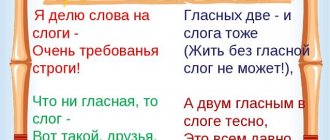
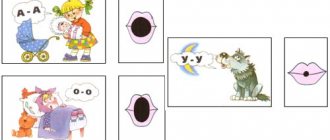

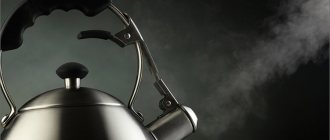
![Visual and didactic manual on sound automation [C] “Interesting cards”](https://lubcentre.ru/wp-content/uploads/naglyadno-didakticheskoe-posobie-po-avtomatizacii-zvuka-s-interesnye-kartochki-330x140.jpg)
